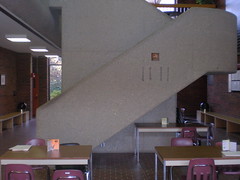Tuesday, October 23, 2007
Tuesday, October 9, 2007
Reaction: Chapter 9
Chapter 9 is the concluding chapter to the book. It attempts to answer the question of "what is all this technology going to mean for the classroom?" I think it is important to keep in mind, and the book alludes to this, that the internet is getting bigger and bigger, and students will be able to use it more for their education. The book mentions where before, students would have to research in libraries and books that would require large amounts of time that they would not do anyways, now students can simply Google whatever it is they want to look up. This is an interesting time in education. Technologies like blogs and podcasting mean that not only will students be learning, but teachers and people outside of the classroom can learn as well from what is being posted on the web. Classes will become more of a collaborative effort between students and faculty. It will be interesting to compare education in 1989 to education in 1999 and then in 2009.
Tuesday, October 2, 2007
Chapter 6
Chapter 6 is about social bookmarking web sites. The main web site mentioned in the text is Furl, which I must admit I never heard of, but then again I had also never heard of social bookmarking. It is an interesting idea however. For example, if I am doing a research project on dolphins, I can use the site to look up what web sites other people have bookmarked on dolphins as well. So instead of working alone to find information, I can use the help of other people as well. It seems like it could be a good tool in the classroom to help make research that much easier.
Tuesday, September 25, 2007
Chapter 8: Podcasting and Screencasting
With the marketing of the ipod, it is amazing how it has all taken off. If you go into any electronics section of a store, you will see ipod inspired everything. Even items not even associated with ipods are named i-something. Podcasting reminds me of q-tips, it could be called audiocasting just like q-tips are cotton swabs, but the brand name stuck. Like RSS feeds, it seems like podcasting is becoming more popular everyday. The main idea I can see that holds educational value with podcasting is the fact that classes can be recorded and the podcast can be posted online for students that would like to hear the lecture again or if the student missed, they could listen to it. Screencasting is a new idea to me, in which audio can be added to computer video. This could be used for some good things as well as with podcasting.
Tuesday, September 11, 2007
Digital Articles: Reaction
Synching up with the iKid and Adopt and Adapt are two articles that deal with using technology in the classroom. Essentially the idea is that technology is here and nothing can be done about it. The students that we will teach in school have grown up with technology and it is like they are hardwired differently than previous generations. There are people who want to stick to the old ways of teaching, but they have failed; using technology in new ways in schools has had some success. They are interesting articles to read. There are even people in the education field that have varying feelings on how technology should be used, whether it is having a totally wired (or wireless) classroom with no books to having just one computer and going from there. Maybe more technology is not the answer, but it appears to help students become more interested in school, and thats something to take note of.
Reading Response: Chapter 4
Where would the world be without Wikipedia? Chapter 4 is all about the use of wikis in the classroom. Personally, I like the idea of using wikis in the classroom. For example, have the students work on a project, say on George Washington, and they could continue adding information or editing the page. In essence, the students could use the wiki to work on a group essay if you will. Wikipedia is a great tool to help students with research, as long as they use it as a springboard to other things.
Tuesday, September 4, 2007
Parallelogram
This is an example of a parallelogram in the real world. Now, go out into the real world and find 10 examples of geometric shapes in real life. Then, post them to your Flickr account and use the 'Add Note" feature to tell us what the shape is. If you click on the picture of the parallelogram, it will take you to my Flickr account with several other examples of real-life geometric shapes.
Subscribe to:
Posts (Atom)
